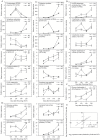Transcriptome changes during fruit development and ripening of sweet orange (Citrus sinensis)
- PMID: 22230690
- PMCID: PMC3267696
- DOI: 10.1186/1471-2164-13-10
Transcriptome changes during fruit development and ripening of sweet orange (Citrus sinensis)
Abstract
Background: The transcriptome of the fruit pulp of the sweet orange variety Anliu (WT) and that of its red fleshed mutant Hong Anliu (MT) were compared to understand the dynamics and differential expression of genes expressed during fruit development and ripening.
Results: The transcriptomes of WT and MT were sampled at four developmental stages using an Illumina sequencing platform. A total of 19,440 and 18,829 genes were detected in MT and WT, respectively. Hierarchical clustering analysis revealed 24 expression patterns for the set of all genes detected, of which 20 were in common between MT and WT. Over 89% of the genes showed differential expression during fruit development and ripening in the WT. Functional categorization of the differentially expressed genes revealed that cell wall biosynthesis, carbohydrate and citric acid metabolism, carotenoid metabolism, and the response to stress were the most differentially regulated processes occurring during fruit development and ripening.
Conclusion: A description of the transcriptomic changes occurring during fruit development and ripening was obtained in sweet orange, along with a dynamic view of the gene expression differences between the wild type and a red fleshed mutant.
© 2012 Yu et al; licensee BioMed Central Ltd.
Figures





References
-
- Coombe BG. The Development of Fleshy Fruits. Annu Rev Plant Physiol. 1976;27:207–228. doi: 10.1146/annurev.pp.27.060176.001231. - DOI
-
- Iglesias DJ, Cercós M, Colmenero-Flores JM, Naranjo MA, Ríos G, Carrera E, Ruiz-Rivero O, Lliso I, Morillon R, Tadeo FR, Talon M. Physiology of citrus fruiting. Braz J Plant Physiol. 2007;19:333–362.
-
- Bain JM. Morphological, anatomical, and physiological changes in the developing fruit of the Valencia orange, Citrus sinensis (L) Osbeck. Aust J Bot. 1958;6(1):1–23. doi: 10.1071/BT9580001. - DOI
Publication types
MeSH terms
Substances
LinkOut - more resources
Full Text Sources
Molecular Biology Databases

